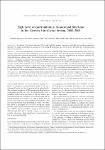High Level of Gastrointestinal Nosocomial Infections in the German Surveillance System, 2002–2008
Spackova, Michaela
Altmann, Doris
Eckmanns, Tim
Koch, Judith
Krause, Gérard
Objective: Surveillance of nosocomial infections (NIs) is well established in many countries but often does not include gastrointestinal infections. We sought to determine the proportion of NIs among all hospitalized cases for the 4 most prevalent types of gastrointestinal infections in Germany. Methods: We analyzed all notifications of laboratory-confirmed or epidemiologically linked gastrointestinal infections due to norovirus, rotavirus, Salmonella species, and Campylobacter species reported to the Robert Koch Institute in Berlin, Germany, from 2002 through 2008. Infections were considered nosocomial if disease onset was more than 2 days after hospitalization for norovirus, rotavirus, and Salmonella infection and more than 5 days after hospitalization for Campylobacter infection. Results: During the study period, 710,725 norovirus, 394,500 rotavirus, 395,736 Salmonella, and 405,234 Campylobacter gastrointestinal infections were reported. Excluding cases for which nosocomial status could not be determined, we identified 39,424 (49%) of 80,650 norovirus, 11,592 (14%) of 83,451 rotavirus, 3,432 (8%) of 43,348 Salmonella, and 645 (2%) of 33,503 Campylobacter gastrointestinal infections as definite nosocomial cases. Multivariate analysis confirmed higher risk of gastrointestinal NIs for patients aged more than 70 years (relative risk [RR], 7.0 [95% confidence interval {CI}, 6.7-7.2]; [Formula: see text]) and residents of western states (RR, 1.3 [95% CI, 1.2-1.3]; [Formula: see text]) and lower risk for female patients (RR, 0.9 [95% CI, 0.9-0.9; [Formula: see text]). Yearly NI proportions remained stable except for norovirus. Conclusions: The investigated gastrointestinal NIs in Germany do not show a clear trend, but they are at high level, revealing potential for public health action and improvement of hospital infection control mainly among older patients. National prevalence studies on gastrointestinal NIs would be of additional value to give more insight on how and where to improve hospital infection control.
No license information
Related Items
Show related Items with similar Title, Author, Creator or Subject.
-
2010-10-14ZeitschriftenartikelMethicillin-resistant Staphylococcus aureus (MRSA): burden of disease and control challenges in Europe Köck, Robin; Becker, Karsten; Cookson, B.; Gemert-Pijnen, J. E. van; Harbarth, S.; Kluytmans, J.; Mielke, Martin; Peters, G.; Skov, R. L.; Struelens, M. J.; Tacconelli, E.; Torné, A. Navarro; Witte, Wolfgang; Friedrich, Alexander W.Methicillin-resistant Staphylococcus aureus (MRSA) is a major cause of healthcare- and community-associated infections worldwide. Within the healthcare setting alone, MRSA infections are estimated to affect more than 150,000 ...
-
2011-06-02ZeitschriftenartikelClusters of infectious diseases in German nursing homes – observations from a prospective infection surveillance study, October 2008 to August 2009 Schulz, Mathias; Mielke, Martin; Wischnewski, NicolettaA prospective infection surveillance study was carried out among residents of seven nursing homes in and around Berlin, Germany, from October 2008 to August 2009. A considerable number of infections were found to occur in ...
-
2009-07-01ZeitschriftenartikelEmergence of a community-associated methicillin-resistant Staphylococcus aureus with unique resistance profile in Southwest of Nigeria Ghebremedhin, B.; Olugbosi, M. O.; Raji, A. M.; Layer, Franziska; Bakare, R. A.; König, B.; König, WolfgangPheno-, genotypic and toxin gene analysis has not been done yet all in one for Nigerian Staphylococcus aureus population. This study provides a comprehensive overview on the molecular epidemiology and genetic diversity of ...

